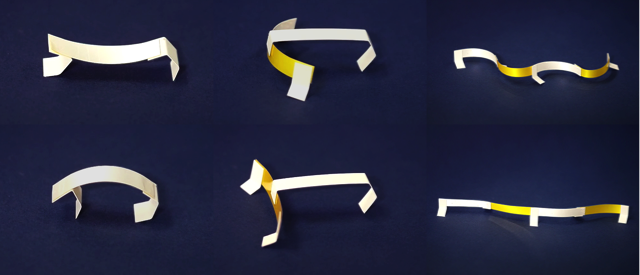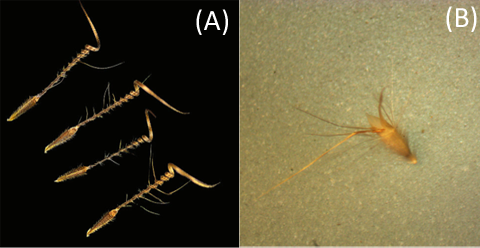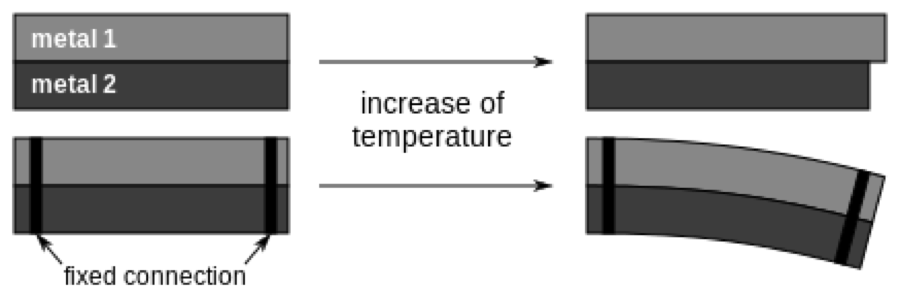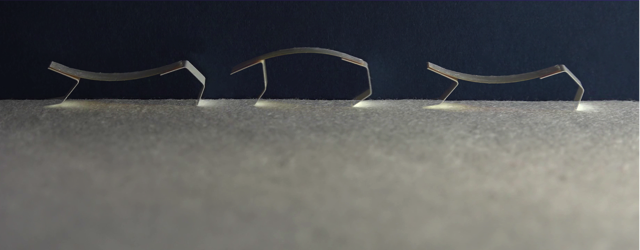Meet the Tiny Machines that Harness Humidity for Power
May 15, 2018
What could we do with machines that draw power from the air around us? That’s the idea behind these bio-inspired bots, mechanically fueled by water in the air! They are hygroscopic, absorbing water from the atmosphere and changing shape as they do so, and various clever designs allow them to use that fact to propel themselves.

Fig. 1: Various designs of hygrobots.
Image Credit: H.-Y. Kim (Seoul National University)
Inspired by Nature
In recent research published in Science Robotics, the creators of hygrobots describe nature as being their guide. Plants don’t seem to move around much, but seeds find ways to dig themselves into the soil, and plants bend toward light and move upward and outward.
-
A wild oat seed uses its long, hygroscopic hairs to move.
It is the hygroexpansive properties of plants, driven primarily by the transport of fluid, that allow this. For example, the Erodium moschatum seeds and the grass seed pictured below have a layer of aligned hygroscopically active cells, which expand as they absorb water, positioned over top of a layer of hygroscopically inactive cells, which do not expand.

Fig. 2: (A) Erodium moschatum seed By Roger Culos - Own work (CC BY-SA 3.0), (B) fine hairs can be seen on this grass seed. By Harry Rose from South West Rocks, Australia (CC BY 2.0),
The Erodium moschatum seed (Fig. 2A) can dig itself into the ground by expanding when its hygroscopic layer gets wet, and helically coiling its way down into the ground as it dries and contracts. Other awn type seeds (seeds with hairs or bristles) such as the grass seed (Fig. 2B) have fine hairs, which behave like a ratchet. As water condenses from the air during the night and early morning, the hygroscopic layer of cells absorb moisture and expand, pushing the seed’s point (on the bottom right of Fig. 2B) into the ground. Later in the day, as the seed dries, it contracts—but the fine hairs hold it in place, like a ratchet, preventing the seed from upward motion.
Bilayers
Bilayers, formed by two stacked sheets of materials with different properties, are at the heart of a number of engineered systems. For example, bimetallic circuit breakers are created with two layers of metal on a strip; when a current goes through the metals, they heat up and they expand in different proportions. If the current reaches a certain amount, one metal will expand much more, but since the two metals are connected together, they begin to curve. It is this curvature that breaks open the circuit, stopping the flow of electricity.

Figure 3. This image shows how different metals expand with heating, and how when they are fixed together, a bending must occur with the metal expanding a greater amount on the outer radius of the curve.
Image Credit: By Patrick87 (CC BY-SA 3.0)
Bimetallic strips are often used in heating systems. In older thermostats, a bimetallic coil would expand or contract, causing a circuit to open or close.

Fig 4. A video showing the heating of a bimetallic strip.
Image Credit: By Hustvedt (Own work) (CC BY-SA 3.0) via Wikimedia Commons
Bringing Bilayers to Bots
The key for the scientists was to create a bilayer that caused motion, but to force that motion in one direction required the creation of a “ratchet”-style mechanism, like in the seeds discussed above.
First, the scientists created structures with a layer of hygroscopically active polyethylene oxide (PEO) nanofibers, to test how the fibers’ alignment affected the expansion of the active layer. They subjected different structures to a rapid increase in humidity, and measured how quickly they curved and how much they curved. They found that when the layer of active fibers were uniformly aligned rather than randomly placed, they responded significantly quicker, curved toward the inactive layer a greater amount, and expanded in a uniform direction. The scientists also considered how thick the hygroscopic active layer should be, and found that the time for the layer to saturate was much more rapid when the layers were aligned. They believe this to be due to greater porosity in the aligned structure.
With this information, the scientists could determine how the bilayer would bend – that is how much stress and strain would be placed on the active layer, and the change in curvature of the system with the influx of water molecules (from humidity in the air). In physics, the amount of expansion that occurs divided by the original length is called the strain, and is a measure of the object’s deformation. The object changes length due to the amount of force per area on the object; this quantity is called stress. They also tested the durability of the bilayer; after over 10,000 trials with varying relative humidity, the researchers found that the curvature decreased by about 17% from its initial maximum.
The Bots: Design
Recall that as the bilayer absorbs water molecules, the active layer elongates, causing the bilayer to curve toward the inactive layer. As the system dries, the active layer shortens again. To create a bot that moves in one direction with the best possible step length, the inactive layer is made a little longer than the active layer, so that the bilayer naturally bends toward the inactive side when dry. Then two ratchets – or feet – are placed on the bilayer, to prevent the bot from moving back to where it started when the layers dry out.
When the active layer absorbs water, it expands causing the hygrobot to arch its back toward the sky, pulling the back foot forward (shown on the left side of the bot in Fig 5) while the front foot holds it in place. As the active layer dries, the hygrobot bends its back downward, toward the ground, pushing the front foot forward (right foot in Fig 5), while the back foot holds it in place. This design of the hygrobot also allows for maximum motion due to a gradient of humidity from a damp or wet surface. When the hygrobot is in its lowest position, near the surface, it is in a region of greater humidity. After it has absorbed water and arched its back upward, it is in a region of lower humidity, where it begins to dry.

Fig. 5: Hygrobot walking.
Image Credit: H.Y. Kim (Seoul National University)
-
A video from the study's authors, displaying hygrobots of various shapes walking in real time and fast-motion.
Video Credit: H.Y. Kim (Seoul National University).
Future Research and Development
The scientists note in their paper that the ability of the hygrobot to be powered by mere moisture can be utilized in a number of applications, including military and biomedical settings. In one test described in the paper, the hygrobot’s feet were coated with antibiotics and it was placed on an agar plate, traversing a landscape of bacteria based on the humidity gradient. It did quite well in sterilizing a good portion of the plate during a 24 hour period.
The scientists are currently considering other actuated motion, such as rotational motion, like in the case of the plant seed shown in Fig. 1A. They are also considering other bots based on different environmental conditions. They state “...we may be able to build sensors that produce mechanical responses to the concentration of specific gas molecules.”
What problems could these miniature machines, powered by the water in the air around them, solve? Only time—and creative application of these new devices—will tell…but without a doubt, these bots have many possibilities!
References and Resources
1. Shin, B., et al.,“Hygrobot: A self-locomotive ratcheted actuator powered by environmental humidty,” Sci. Robotics 3, 14, (2018). http://robotics.sciencemag.org/content/3/14/eaar2629 DOI: 10.1126/scirobotics.aar2629
—H.M. Doss














